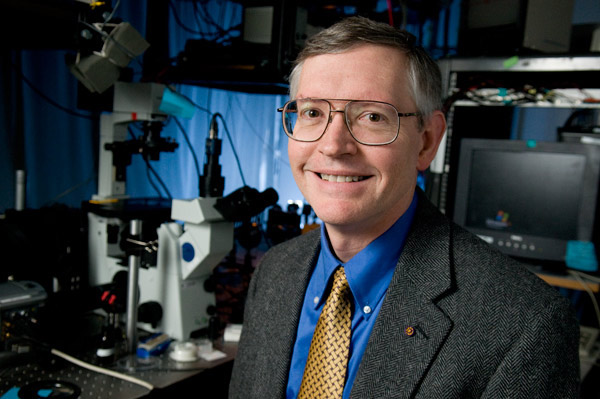
By:
- Kim McDonald
Published Date
By:
- Kim McDonald
Share This:
Former UC San Diego Professor Wins 2014 Nobel Prize in Chemistry
William E. Moerner, one of three scientists who this week were named winners of the 2014 Nobel Prize in Chemistry, first applied his Nobel Prize-winning discovery to biological problems while working in the basement of Urey Hall as a professor of chemistry and biochemistry at UC San Diego from 1995 to 1998.

William E. Moerner, one of three scientists who this week were named winners of the 2014 Nobel Prize in Chemistry.
Although he had already laid the foundations for the discovery for which he won his Nobel Prize, “single-molecule microscopy” while at the IBM Almaden Research Center in San Jose, his subsequent research and collaborations with UC San Diego biochemists and organic chemists enabled him to later apply the technique to critical problems in health and medicine after he arrived on the La Jolla campus.
Moerner worked closely with 2008 Nobel Chemistry Prize winner Roger Tsein, a professor of pharmacology, chemistry and biochemistry. The campus is also home to Mario Molina, a distinguished professor of chemistry and biochemistry, who won the Nobel Prize in Chemistry in 1995 and in May was awarded the UCSD Medal, the highest honor the university bestows.
Moerner, who left UC San Diego for Stanford University in 1998, shared his Nobel Prize with Eric Betzig of the Howard Hughes Medical Institute and Stefan W. Hell of the Max Planck Institute for Biophysical Chemistry in Göttingen. He is affectionately known to close friends and colleagues as “W. E.,” the first two initials of his name.
“W. E. was a fantastic colleague here and a friend,” said Mark Thiemens, Dean of the Division of Physical Sciences who still regularly communicates with Moerner and sees him several times a year at meetings. “His discovery of single molecule spectroscopy was a masterpiece and the applications are everywhere, from medicine to pure chemistry.”
Katja Lindenberg, distinguished professor, was chair of the department of chemistry and biochemistry when Moerner was recruited in 1995 as the first distinguished chair in physical chemistry.
“He already at that time was essentially known as the inventor of single-molecule spectroscopy, but in his position at IBM, his work had focused more on photorefractive polymers, with potential applications to data storage and other industrially relevant problems,” said Robert Continetti, a professor of chemistry and biochemistry who collaborated with Moerner and also worked in an adjacent laboratory to his in the basement of Urey Hall. “In my opinion, his period at UC San Diego played an important role in his Nobel Prize, because it was during this period that W.E., as he is known, began to collaborate with biochemists on some of the essential problems in health that were specifically cited by the Royal Swedish Academy of Sciences in awarding the Nobel Prize.”
At UC San Diego, Moerner oversaw a research group that collaborated widely with others on campus and included four postdoctoral research associates, three graduate students and three undergraduates.
“It was here at UC San Diego, with our tradition of broad interdisciplinary collaboration, that W.E. began to work on a broader range of applications for his single-molecule 'magic',” said Continetti. “In 1997, in collaboration with Roger Tsien, W.E. first reported applying his technique to the green fluorescent protein (GFP) that has proven to be such a valuable tool in elucidating biological phenomena. This is the same GFP for which Tsien was awarded the Nobel Prize.”
Continetti remembers that Moerner also collaborated with former UC San Diego professor “and organic chemist Jay Siegel on studies of photorefractive polymers as well as on the action of muscle fibers with Larry Goldstein, the current director of the stem cell institute – the Sanford Consortium for Regenerative Medicine, and others.”
“W.E. was trained as a physicist and is the consummate, careful experimental scientist,” added Continetti. “We were obviously sad to see him leave for Stanford. But the open research environment here at UC San Diego played a role in his future success, and we can be proud of that.”
Besides the fruitful collaborations Moerner left behind, Moerner keeps one other reminder of his Nobel legacy outside the doors of his old laboratory in the basement of Urey Hall—a laboratory which Continetti now occupies. “It still has W.E.'s sign on the front,” said Continetti, “'Single-Molecule Nano-Photonics Laboratory'.”
Share This:
You May Also Like
Stay in the Know
Keep up with all the latest from UC San Diego. Subscribe to the newsletter today.


